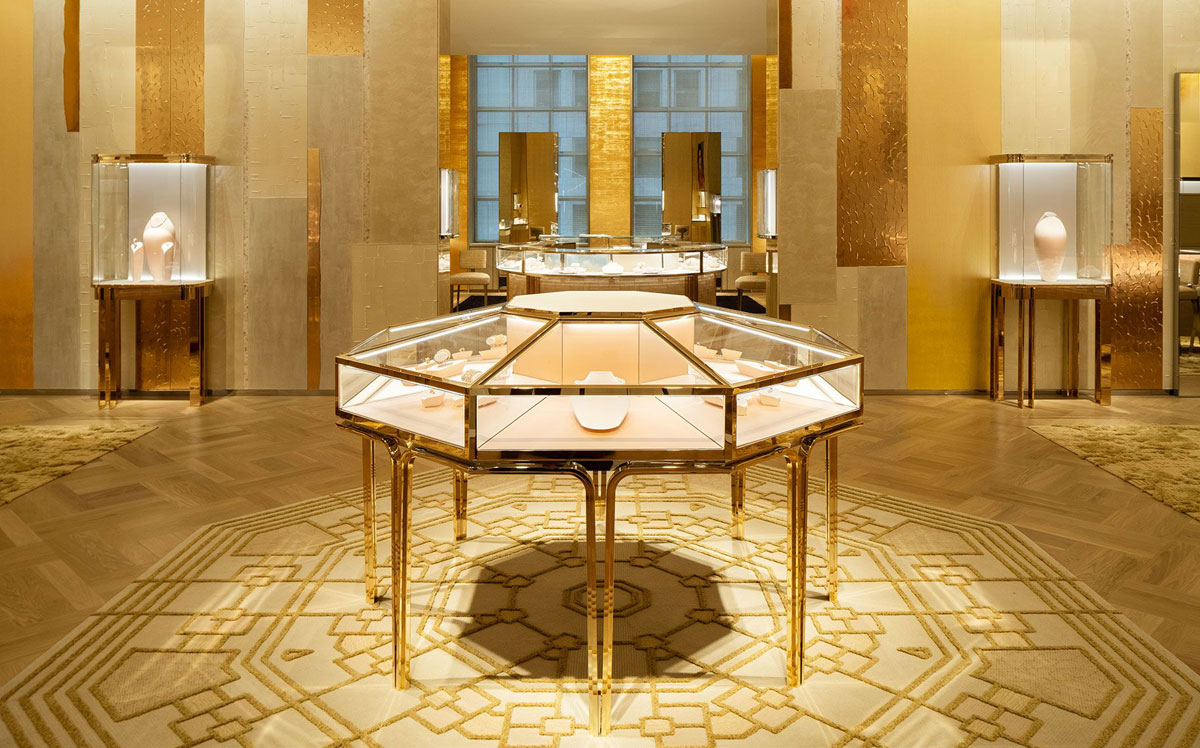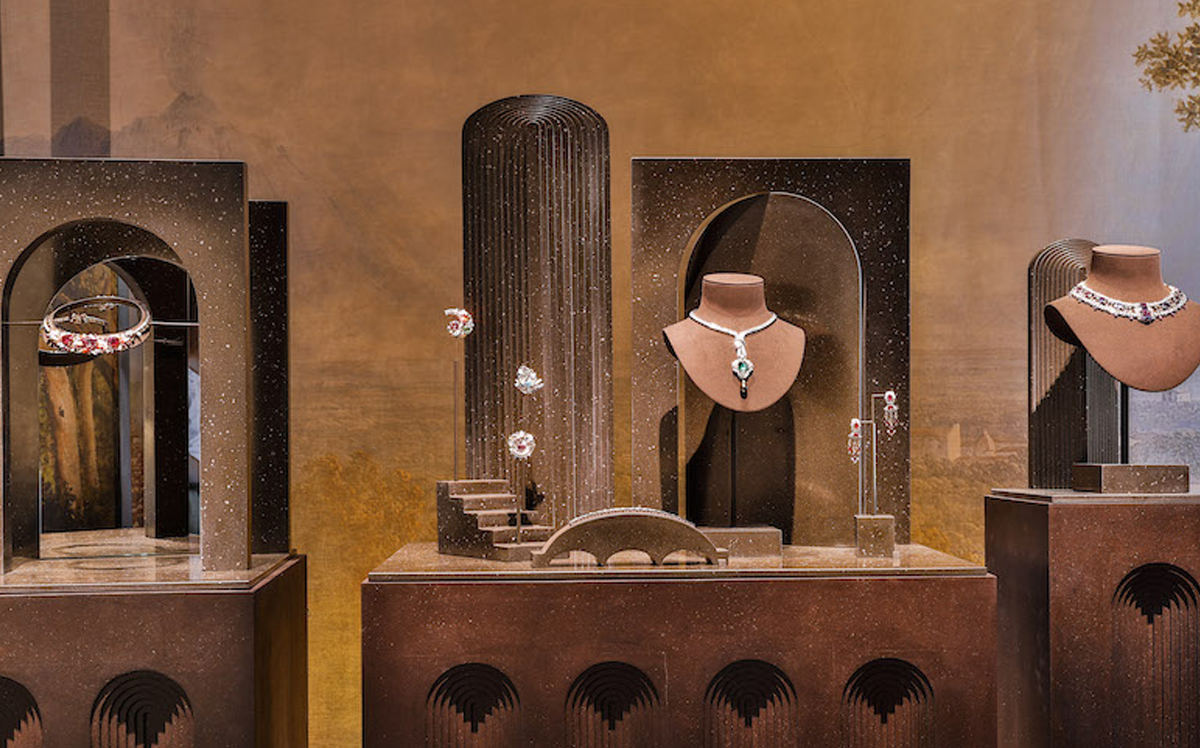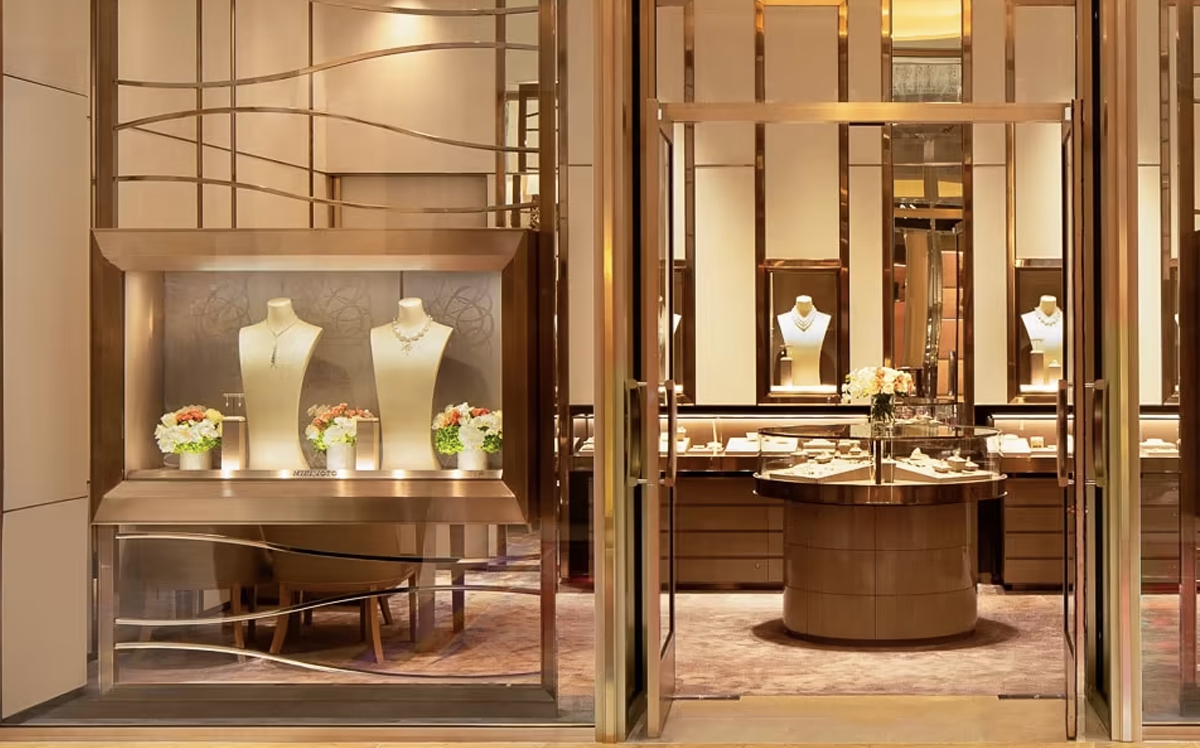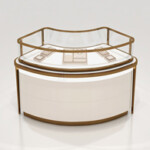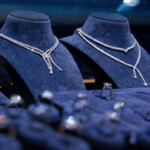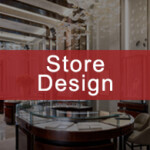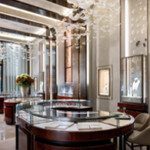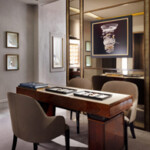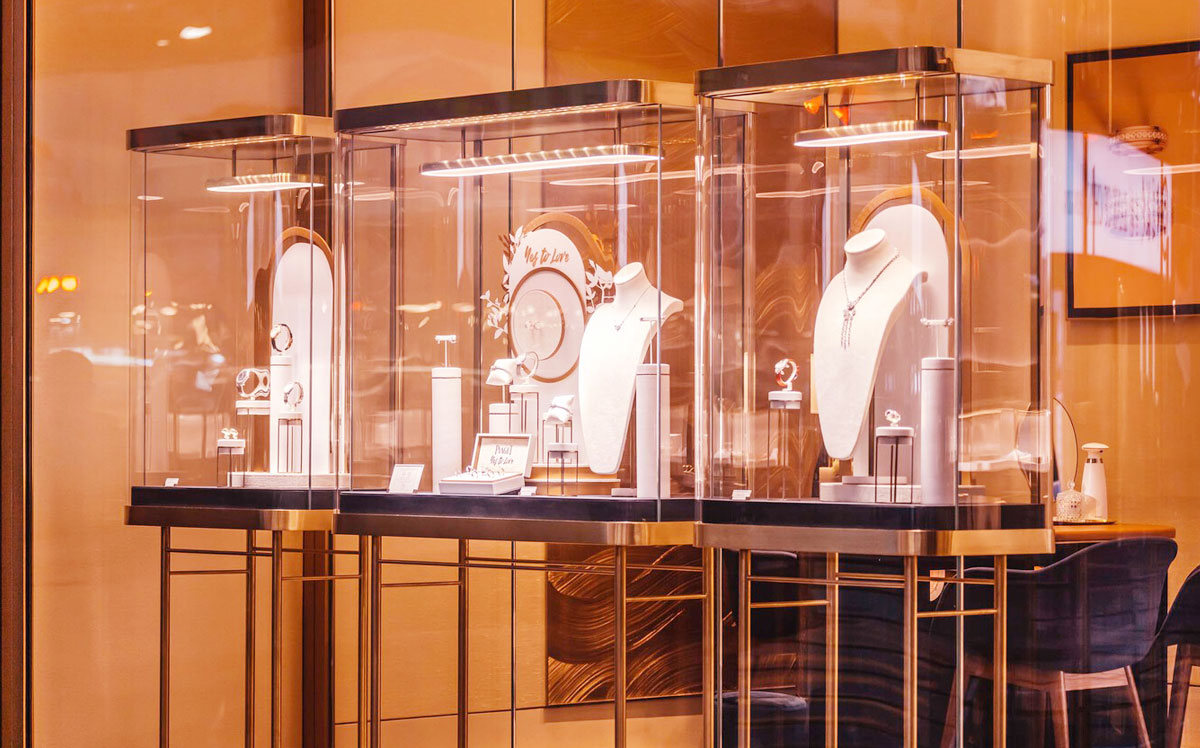
Introduction
A jewelry showcase is more than a display—it represents the brand. For luxury brands, the right showcase makes jewelry look more valuable. It also creates an exclusive shopping experience.
Furthermore, these displays help memorably tell a brand’s story.
Beyond protection, a well-designed showcase elevates jewelry’s beauty. For example, strategic lighting enhances brilliance while guiding customers into the brand’s world.
More importantly, custom designs craft a unique store atmosphere, setting luxury brands apart from competitors.
What You Will Learn in This Guide
This guide covers jewelry showcase essentials: design, materials, lighting, security, and branding. Whether you’re a distributor, retailer, or brand agent, you’ll learn to confidently select or customize high-end displays that align with your goals.
Section 1: What is a Jewelry Showcase?
1.1 Jewelry Showcase: More Than Just a Display Case
A jewelry showcase is far more than a display fixture. In reality, it’s a powerful tool for elevating brand image, protecting valuables, and enhancing customer experiences.
For luxury brands, these showcases act as silent ambassadors, embodying exclusivity, craftsmanship, and prestige.
In high-end retail, showcases go beyond storage. Instead, they craft curated presentations that shape how customers perceive a piece’s value.
Take diamonds as an example: Strategic designs highlight their brilliance, gemstones’ hues, and metals’ elegance—all guiding purchasing decisions.
1.2 Core Functions of a Jewelry Showcase
Luxury jewelry showcases fulfill three critical roles:
🔒 Protection
High-end jewelry requires safeguarding. To achieve this, showcases integrate secure glass, advanced locks, and climate control to prevent theft, damage, and environmental harm.
✨ Presentation
A showcase must amplify—not compete with—the jewelry. Through strategic lighting, premium materials, and smart layouts, it maximizes each piece’s visual appeal.
🎯 Customer Experience
Beyond display, top showcases create immersive interactions. For instance, easy access for staff, optimal viewing angles, and interactive tech deepen customers’ emotional connection to the pieces.
1.3 Why Do Luxury Brands Prefer Custom Jewelry Showcases?
Standard displays suit generic stores, but luxury brands demand custom solutions. Here’s why tailored designs matter:
Brand Consistency
Custom showcases reflect brand identity, from materials to colors. For example, Cartier uses gold accents and deep red tones to reinforce its luxurious appeal.
Tailored Functionality
Different brands have different needs. Watch retailers may require rotating platforms, while diamond boutiques need LED lighting for maximum sparkle.
Enhanced Exclusivity
Custom showcases create a one-of-a-kind shopping experience, making customers feel immersed in a luxurious and personalized retail environment.
Section 1: What is a Jewelry Showcase?
1.1 Jewelry Showcases: More Than Just a Display Case
A jewelry showcase is far more than a display fixture. In reality, it’s a powerful tool for elevating brand image, protecting valuables, and enhancing customer experiences.
For luxury brands, these showcases act as silent ambassadors, embodying exclusivity, craftsmanship, and prestige.
In high-end retail, showcases go beyond storage. Instead, they craft curated presentations that shape how customers perceive a piece’s value.
Take diamonds as an example: Strategic designs highlight their brilliance, gemstones’ hues, and metals’ elegance—all guiding purchasing decisions.
1.2 Core Functions of a Jewelry Showcase
Luxury jewelry showcases serve three primary functions:
🔒 Protection
High-end jewelry requires safeguarding. To achieve this, showcases integrate secure glass, advanced locks, and climate control to prevent theft, damage, and environmental harm.
✨ Presentation
A showcase must amplify—not compete with—the jewelry. Through strategic lighting, premium materials, and smart layouts, it maximizes each piece’s visual appeal.
🎯 Customer Experience
Beyond display, top showcases create immersive interactions. For instance, easy access for staff, optimal viewing angles, and interactive tech deepen customers’ emotional connection to the pieces.
1.3 Why Do Luxury Brands Prefer Custom Jewelry Showcases?
Standard displays suit generic stores, but luxury brands demand custom solutions. Here’s why tailored designs matter:
🎨 Brand Consistency
Custom showcases mirror brand identity through materials and colors. A prime example: Cartier’s gold accents and deep red tones amplify its signature luxury.
⚙️ Tailored Functionality
Brands have unique needs. While watch retailers use rotating platforms, diamond boutiques rely on precision LED lighting to maximize sparkle.
🌟 Enhanced Exclusivity
Custom designs craft unforgettable shopping experiences. By immersing customers in a personalized environment, they elevate perceived value and loyalty.
Section 2: The Evolution and History of Jewelry Showcase
Over the centuries, jewelry showcases have evolved dramatically. From ancient royal vaults to today’s smart displays, they’ve adapted to cultural shifts, technology, and luxury market demands.
Importantly, their history mirrors not just craftsmanship but also branding and customer engagement strategies.
For distributors and agents, understanding this evolution is key. Why? It highlights why custom jewelry showcases matter—and how to predict future trends in luxury retail.
2.1 The Early Days: Royal Treasuries and Aristocratic Displays
Throughout history, jewelry has been a symbol of power, status, and divine connection. Rulers and aristocrats displayed their treasures in elaborate settings to showcase their wealth and influence.
🔍 Ancient Egypt (3000 BCE – 30 BCE)
Pharaohs stored gold and gemstones in ornate chests within palace treasuries. While security was prioritized, these early jewelry showcases laid the foundation for protective design.
🔍 Medieval Europe (5th – 15th Century)
Royal families and the church displayed crowns and relics in locked glass cabinets. Though accessible only to elites, these setups balanced protection with controlled visibility.
🔍 Renaissance & Baroque Eras (16th – 18th Century)
Nobility commissioned custom cabinets with glass fronts and velvet interiors. This shift marked the first focus on aesthetics—highlighting jewels’ beauty alongside their value.
2.2 The Birth of Commercial Jewelry Showcase
As jewelry retail grew, jewelry showcases shifted from storage to strategic sales tools. Here’s how three eras reshaped them:
📜 The 19th Century: Luxury Retail’s Rise
The Industrial Revolution birthed iconic brands like Tiffany & Co. Soon, elite boutiques emerged in cities. Two innovations defined this era:
- Storefront windows became marketing magnets, luring passersby with glittering displays.
- Lockable wooden-and-glass cases balanced security and visibility.
📜 Early 20th Century: Art Deco Elegance
Art Deco transformed jewelry showcases with geometric shapes and brass accents. But the real change? Boutiques began designing displays to create inviting atmospheres, not just to show products.
📜 Mid-20th Century: Modern Retail Demands
As malls and department stores boomed, standardized glass-and-steel showcases dominated. Why? They met the need for mass displays without sacrificing luxury appeal.
2.3 The Transition to High-End, Custom Jewelry Showcase
By the late 20th and early 21st centuries, luxury branding became a key driver in jewelry showcase design. No longer just display units, showcases became essential elements of a brand’s identity.
🎯 Luxury Branding (1990s – Present)
Top brands like Bulgari and Chopard now use bespoke jewelry showcases as brand extensions. Key innovations include:
- Anti-reflective glass and LED lighting to amplify brilliance.
- Showcases seamlessly integrated into store layouts for immersive experiences.
🎯 21st Century Tech Innovations
Today’s jewelry showcases blend cutting-edge tech with design:
- LED Lighting Systems – Enhance diamond sparkle like never before.
- Smart Security Features – Biometric locks and motion sensors for ultra-protection.
- Interactive & Digital Displays – AR and 3D holograms let customers “try” pieces digitally.
2.4 Global Influence: Cultural Approaches to Jewelry Displays
Jewelry showcase styles vary across cultures, reflecting unique aesthetic values and consumer expectations.
🌍 Western Markets: Minimalist Elegance
In Europe and North America, jewelry showcases favor clean lines and premium materials. Key traits:
- Subtle branding via engraved logos.
- Precision lighting to highlight diamonds.
🌏 Asian Markets: Luxe & Tech Fusion
China, Japan, and South Korea embrace opulent designs. Think gold accents, mirrored panels, and interactive digital displays for exclusivity.
🕌 Middle Eastern Markets: Opulent Security
In the UAE and Qatar, grandeur rules. Expect intricate gold details, velvet linings, and advanced security—all tailored for high-net-worth clients.
“Interested in luxury custom jewelry showcase? Contact us for bespoke solutions.”
Send EmailSection 3: Key Features of High-End Custom Jewelry Showcase
A luxury jewelry showcase is no ordinary display. Instead, it’s a crafted tool that boosts brand identity, elevates shopping experiences, and ensures security.
For distributors and agents, knowing these features is vital—the right design must mirror brand values and customer needs.
Here, we break down the essentials: design, materials, lighting, security, and functionality. Master these, and your brand can create a retail space that captivates while shouting exclusivity.
3.1 Design & Aesthetic Appeal
Luxury jewelry showcases blend brand identity with visual appeal. Let’s explore top design styles and custom branding tactics:
💡 Top Design Styles
✅ Minimalist & Contemporary
Clean lines and sleek glass dominate. For example, Tiffany & Co. uses this style to let diamonds shine without distraction.
✅ Opulent & Classic
Gold-plated details and rich textures rule here. Common in Middle Eastern boutiques and European luxury stores.
✅ Vintage & Art Deco
Brass carvings and velvet interiors define this look. Brands like Cartier leverage it to evoke timeless elegance.
💡 Custom Branding Strategies
To boost recognition, brands customize jewelry showcases through:
- Signature colors (e.g., Hermès orange).
- Engraved logos for subtle exclusivity.
- Unique shapes like floating hexagons or circles.
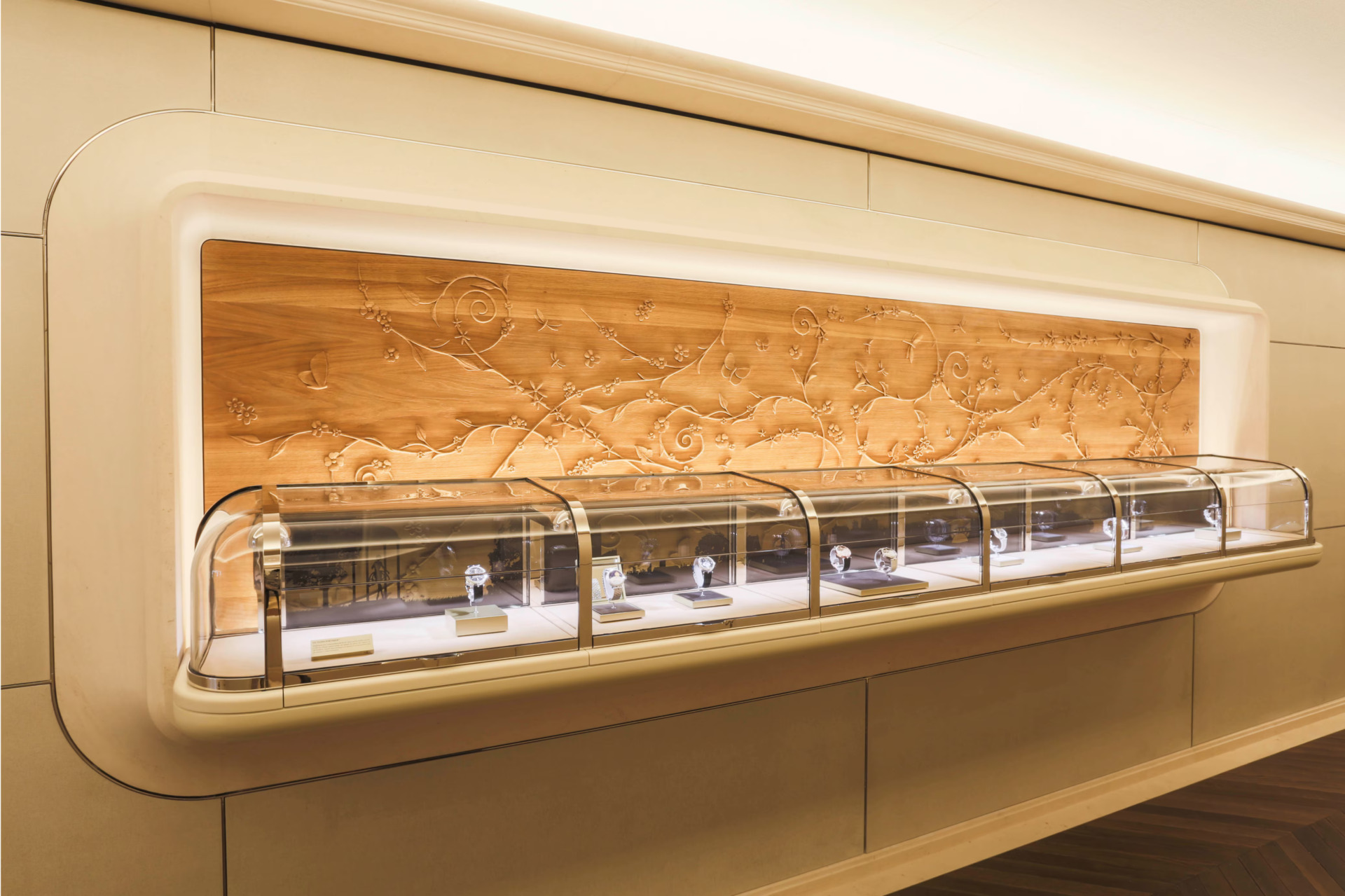
3.2 Materials: Balancing Luxury & Sustainability
Materials define a jewelry showcase’s durability, security, and style. High-end displays use:
🔨 Premium Choices
✅ Glass
– Anti-reflective types cut glare.
– Tempered glass resists breakage.
✅ Metal
– Stainless steel for durability.
– Brass/gold finishes for luxury.
✅ Wood & Veneers
– Solid oak/walnut for classic vibes.
– Lacquered MDF for modern sleekness.
✅ Fabric & Leather
– Velvet linings make jewels pop.
– Leather panels add texture.
🌱 Eco-Friendly Trends
Luxury brands now embrace sustainability. Key moves include:
- FSC-certified wood.
- Recycled glass and energy-saving LEDs.
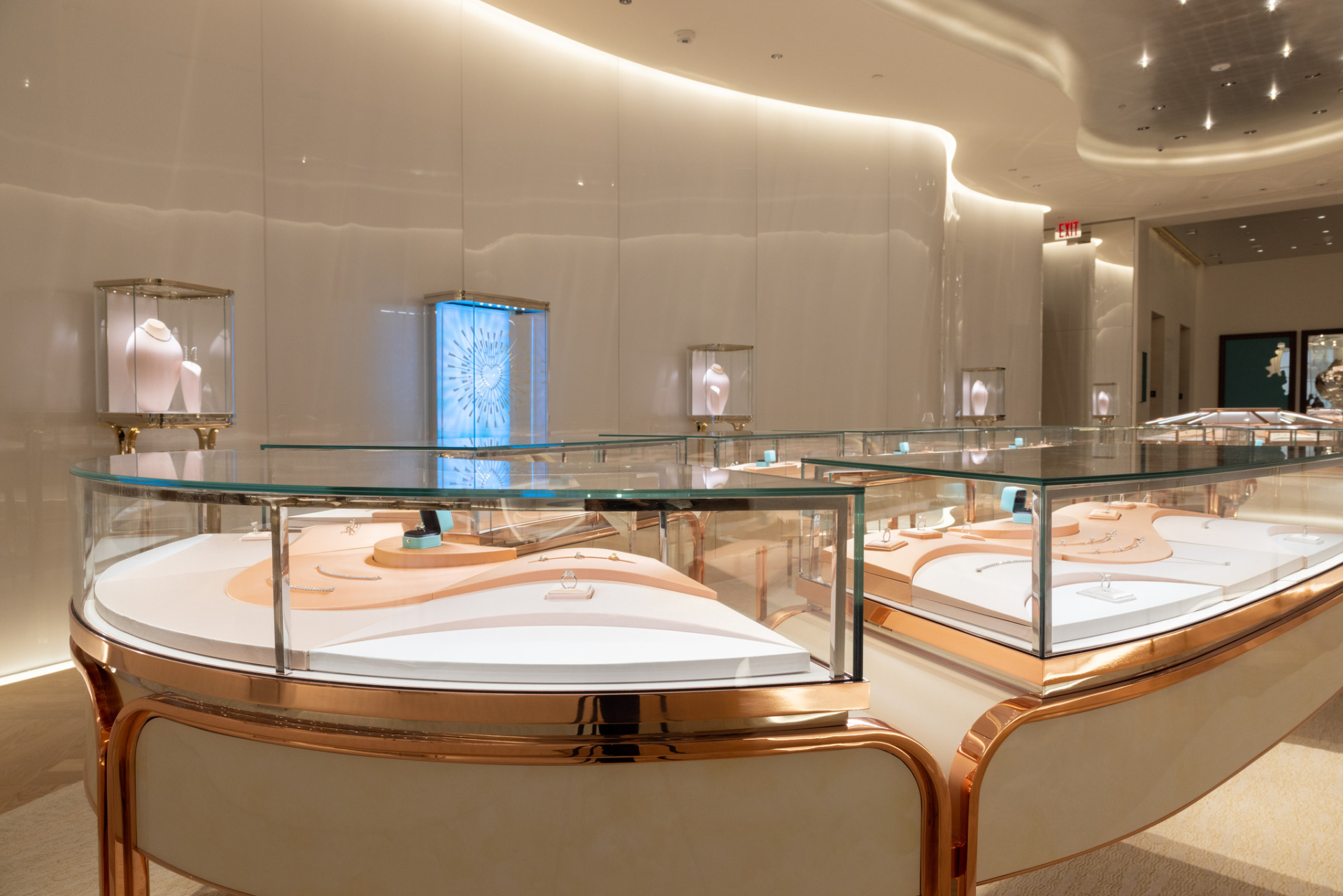
3.3 Lighting: Make Jewelry Shine
Lighting can make or break a jewelry showcase. Here’s how to nail it:
💡 LED Lighting (Top Pick)
– Cool white LEDs (5000K–6500K) boost diamond sparkle.
– Warm LEDs (2700K–3500K) flatter gold and vintage pieces.
– Adjustable brightness adapts to any store mood.
💡 Fiber Optic & Spotlights
– Fiber optics protect gems with low heat.
– Backlit panels spotlight hero pieces.
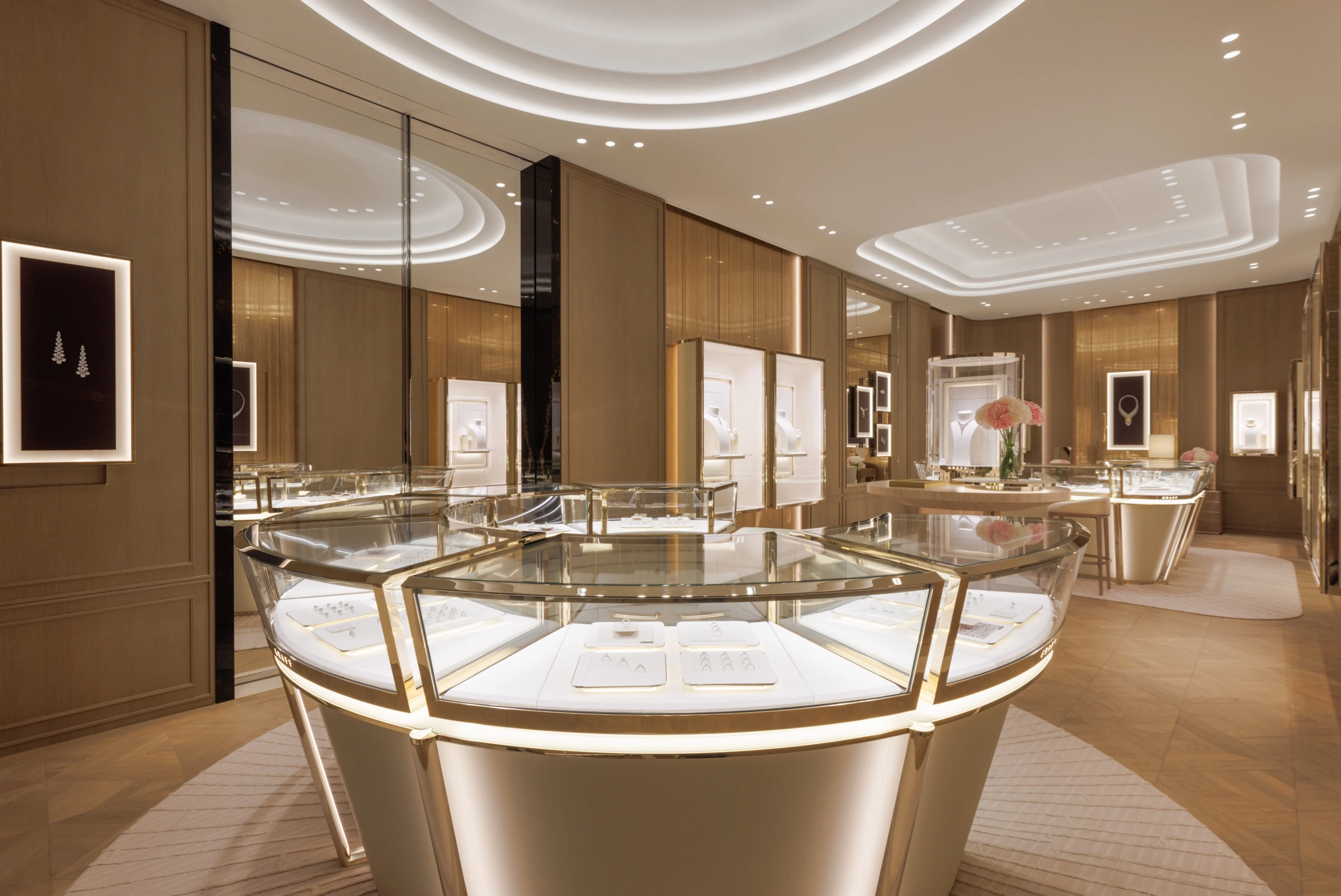
3.4 Security: Invisible Protection
Luxury jewelry showcases need security that doesn’t sacrifice style. Top features include:
🔒 Bulletproof glass against theft.
🔒 Biometric locks and RFID access.
🔒 Hidden motion sensors and cameras.
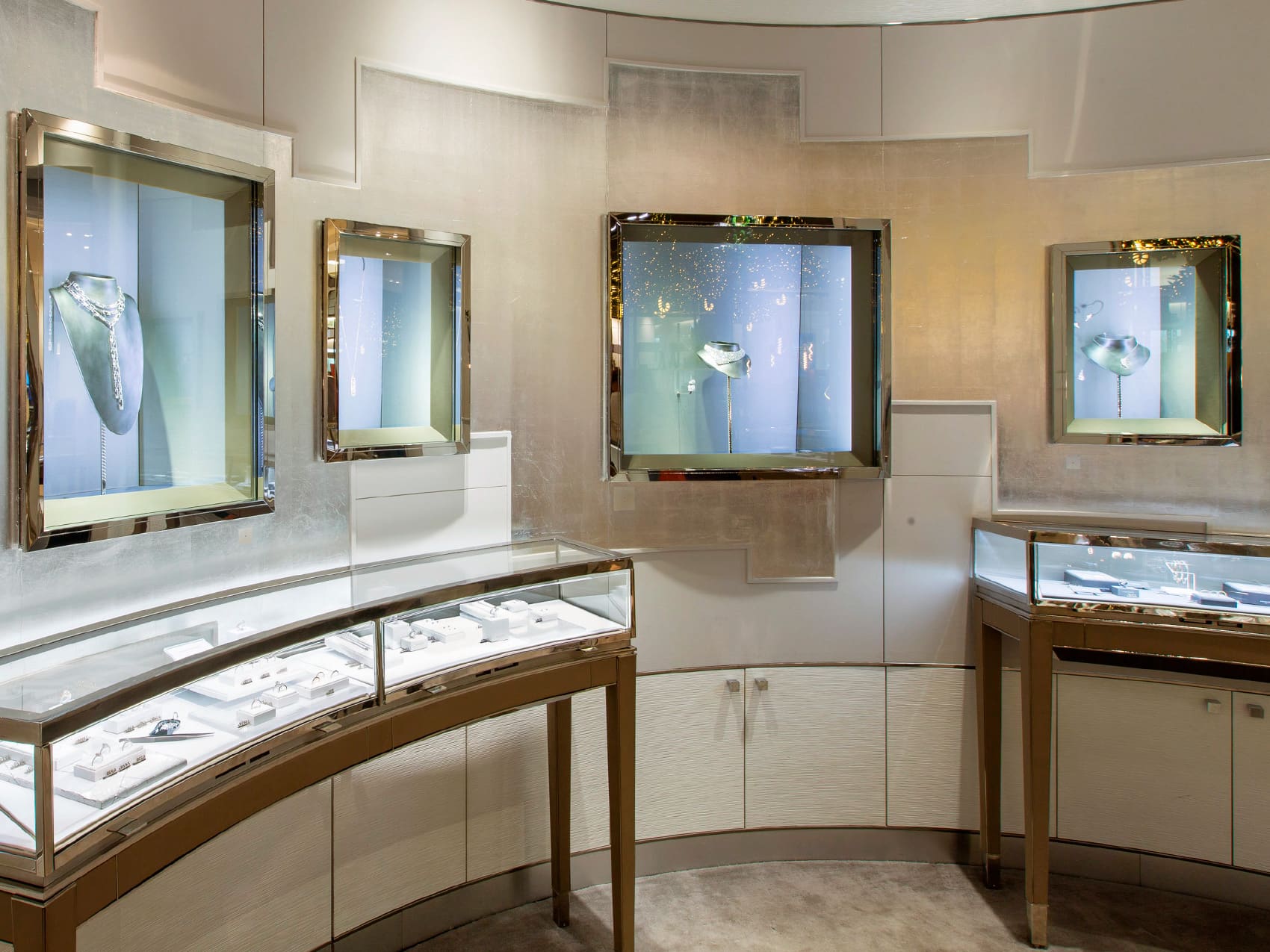
3.5 Functionality: Smart & User-Friendly
A great jewelry showcase balances looks with practicality:
- Ergonomics
📏 Height: 90–110cm for easy viewing.
🎭 Tilting angles for optimal visibility.
🚪 Push-to-open mechanisms for smooth access. - Smart Tech
🔄 Modular systems adapt to seasonal layouts.
📲 Automated rotations and touchscreens boost engagement.
Section 4: Choosing the Right Jewelry Showcase
For luxury distributors and agents, picking the perfect jewelry showcase is critical. Why? Each design serves distinct goals—boosting visibility, saving space, or enhancing security. A smart choice elevates retail spaces and deepens customer connections.
Below, we break down six key jewelry showcase types. Learn their unique strengths to make confident design decisions for boutiques and showrooms.
4.1 Counter Displays: Secure & Interactive
Counter jewelry showcases are retail staples. Positioned at waist height, they let staff present pieces securely while engaging customers face-to-face.
🔑 Key Features
- Glass tops for crystal-clear viewing (no touching needed!).
- Lockable storage below keeps valuables safe.
- Ergonomic design fosters personalized service.
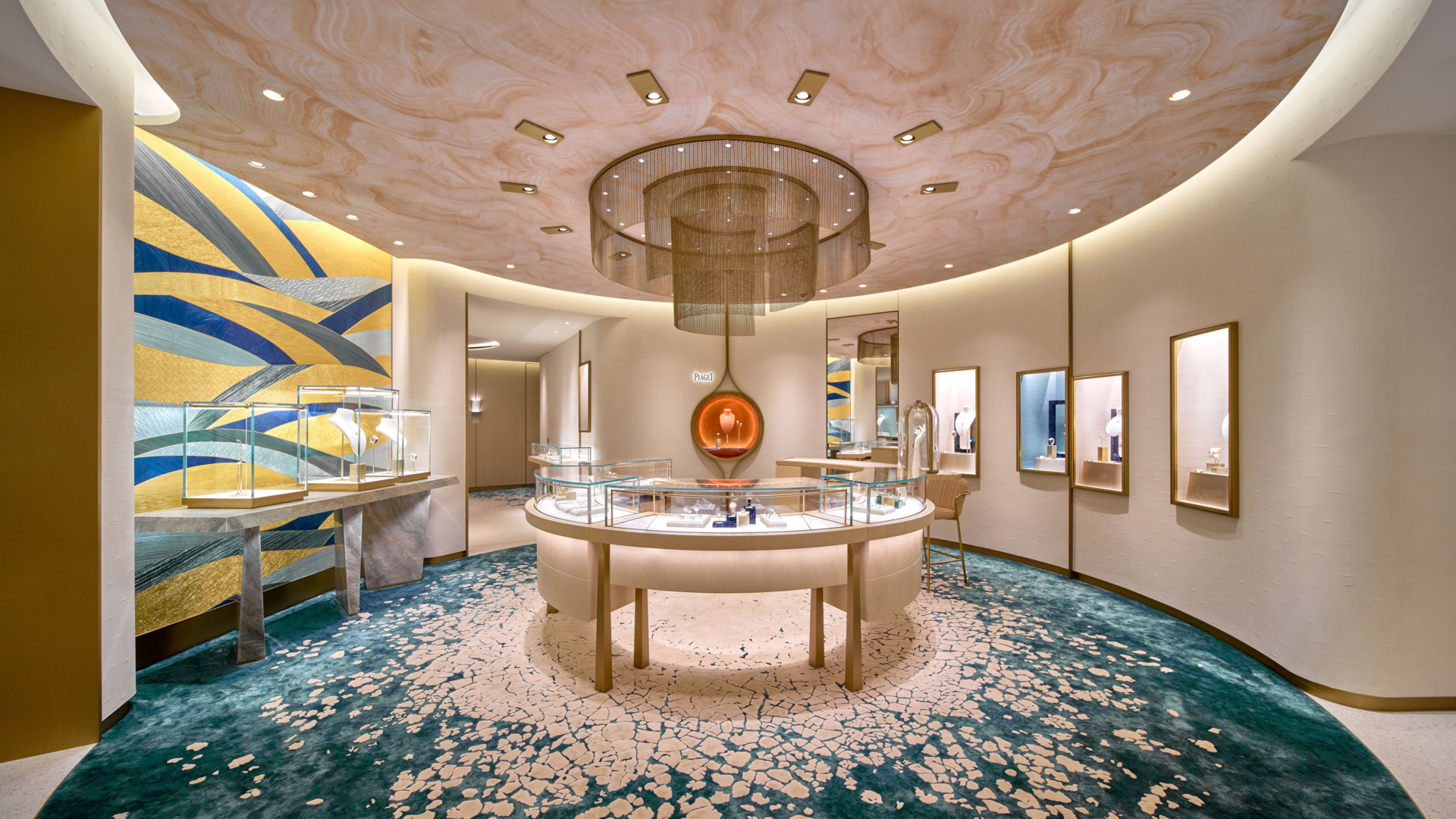
4.2 Wall-Mounted Displays: Space-Saving Luxury
Wall-mounted jewelry showcases turn walls into galleries. Perfect for limited editions, they save floor space while elevating boutique aesthetics.
🔑 Key Features
- Vertical design maximizes space.
- Sleek looks match high-end ambiance.
- Built-in LED lighting highlights the jewels.
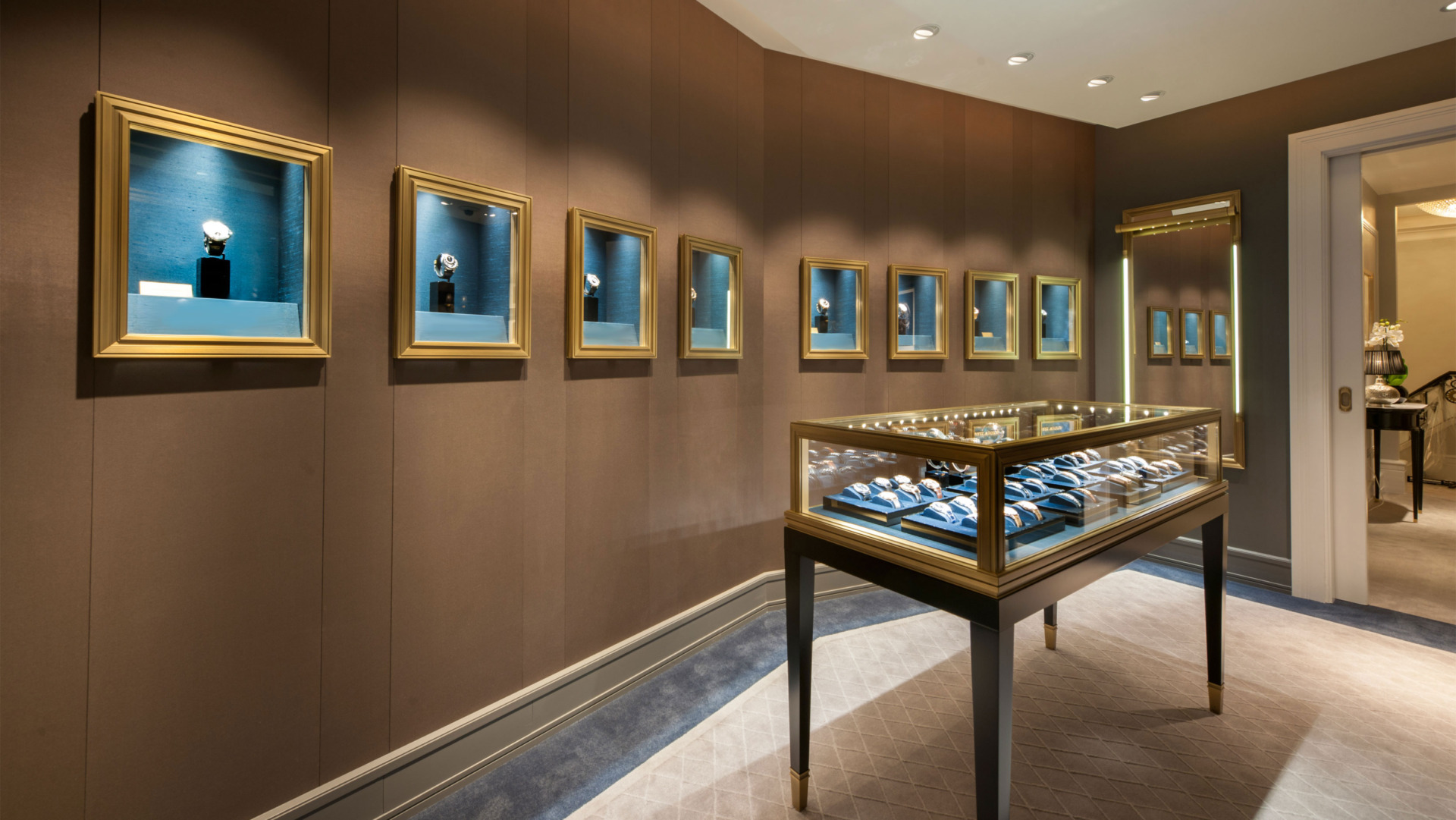
4.3 Freestanding Displays: 360° Spotlight
Center-stage jewelry showcases grab attention for statement pieces. With 360° visibility, they turn jewels into art installations.
🔑 Key Features
- View from every angle.
- Reinforced glass + hidden locks for safety.
- Custom shapes (cylindrical, abstract) to fit brand style.
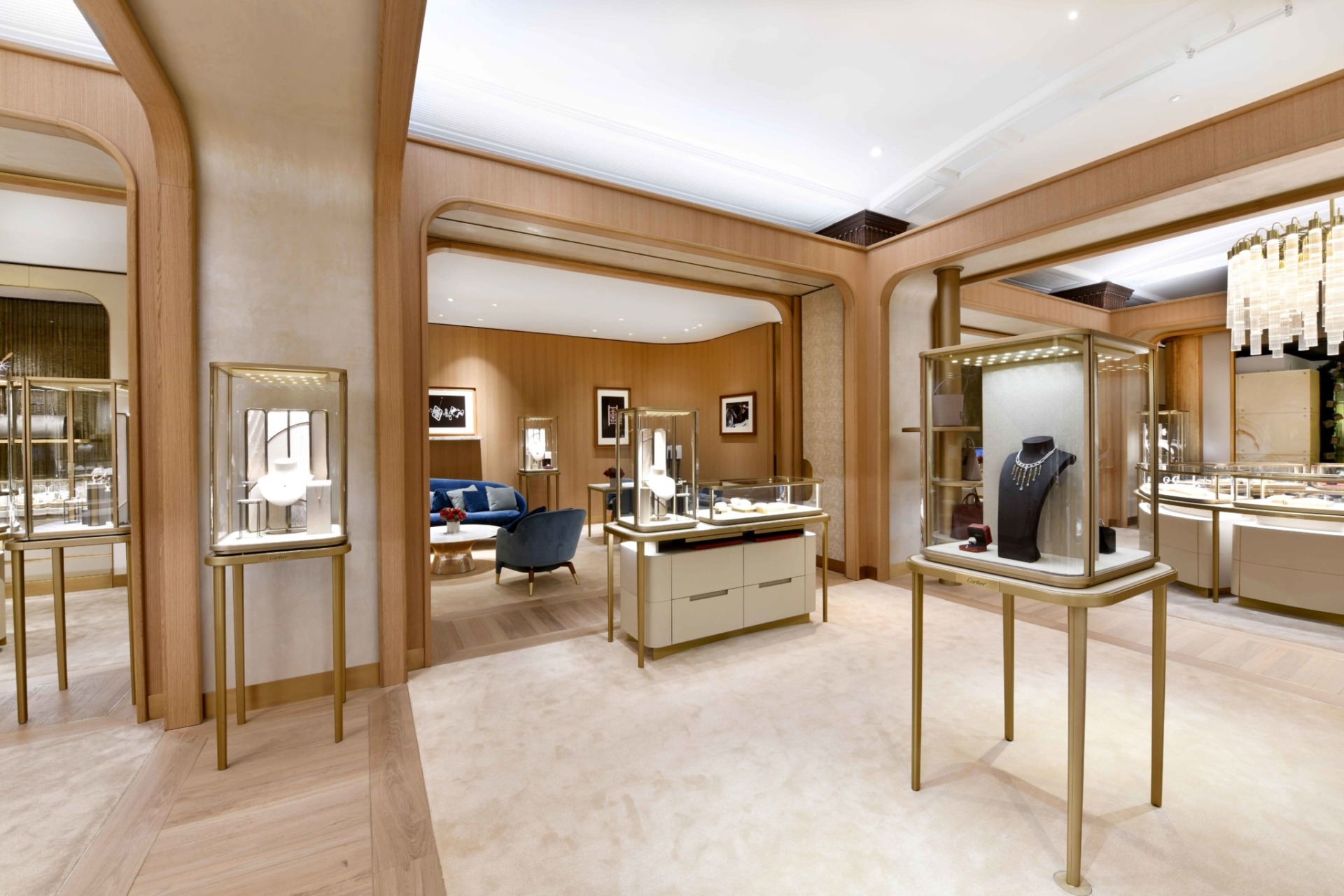
4.4 Window Displays: First Impressions Matter
Window jewelry showcases are marketing powerhouses. They lure passersby, tell brand stories, and spotlight seasonal collections.
🔑 Key Features
- Themed designs scream brand identity.
- Dramatic lighting and layouts stop traffic.
- Quick updates for holidays or promotions.
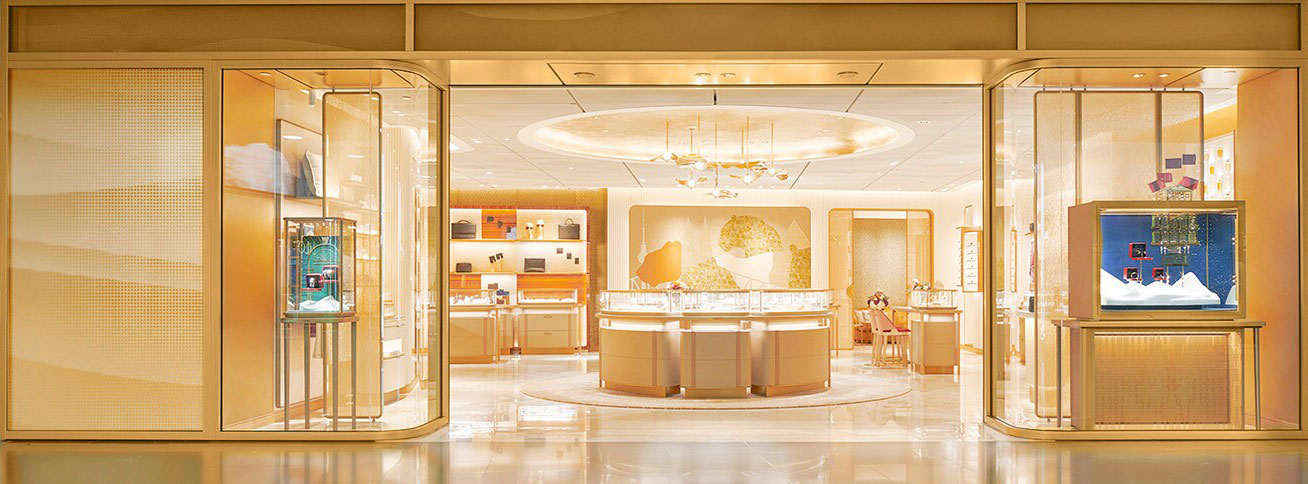
4.5 Portable Displays: Luxury on the Go
Pop-up jewelry showcases let brands shine at events. Despite being lightweight, they keep jewels secure and presentation sharp.
🔑 Key Features
- Easy to move, hard to crack.
- Modular setups fit any space.
- Built-in LEDs for instant glam.
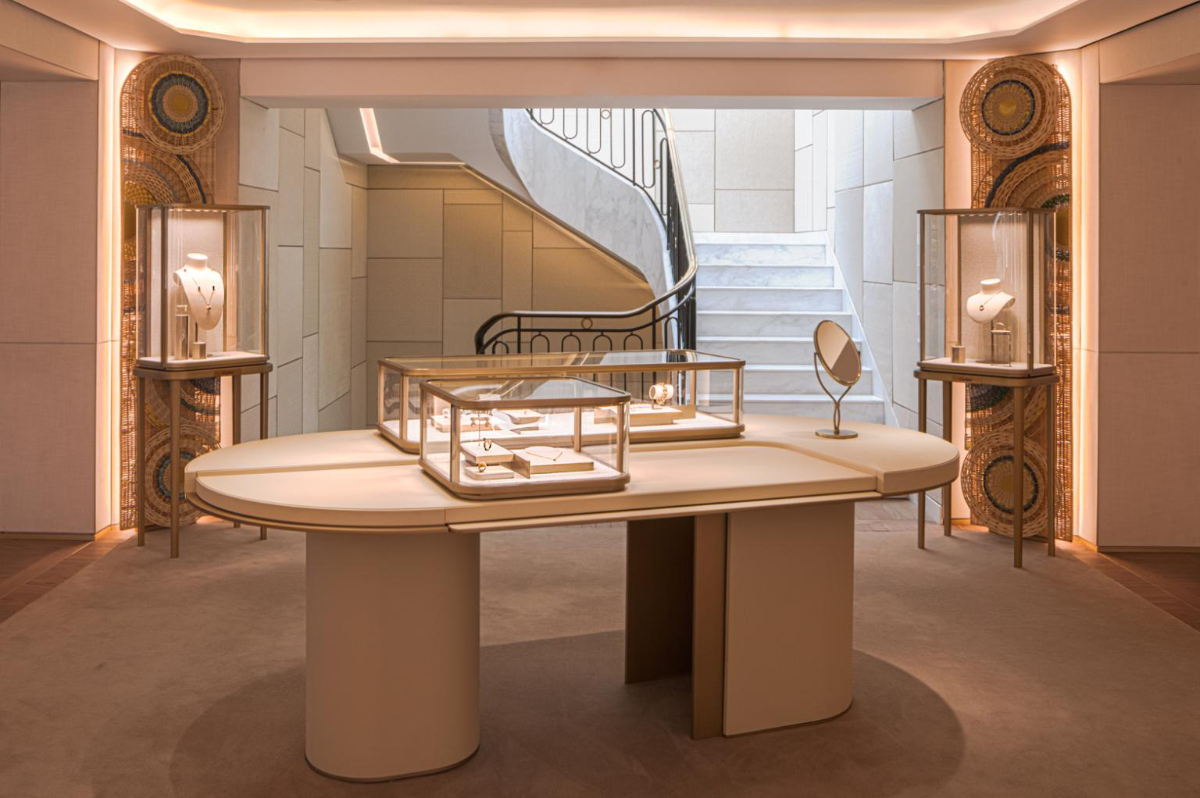
4.6 Smart Displays: Tech Meets Glamour
Smart jewelry showcases blending tech and luxury. Think touchscreens, rotating displays, and theft-proof sensors—all while wowing customers.
🔑 Key Features
- Touchscreens for digital exploration.
- Auto-rotating platforms add drama.
- RFID sensors block sneak grabs.
Section 5: Custom Jewelry Showcase as Brand Powerhouses
Customization transforms a basic jewelry showcase into a powerful brand storyteller. For luxury brands, every detail—including displays—must reflect their identity and leave a lasting impression.
In this section, we explore how custom jewelry showcases enhance brand recognition, strengthen customer relationships, and create seamless luxury experiences.
5.1 Custom Showcase: Storytelling for Luxury Brands
A luxury jewelry showcase is more than just a display—it’s a narrative tool. Consider it a silent ambassador that conveys prestige, sophistication, and exclusivity.
🔍 How They Shape Brand Perception
- Visual Identity: Custom colors and materials reflect the brand’s DNA.
- Customer Trust: Immersive environments foster loyalty.
- Emotional Pull: Unique designs evoke a sense of exclusivity.
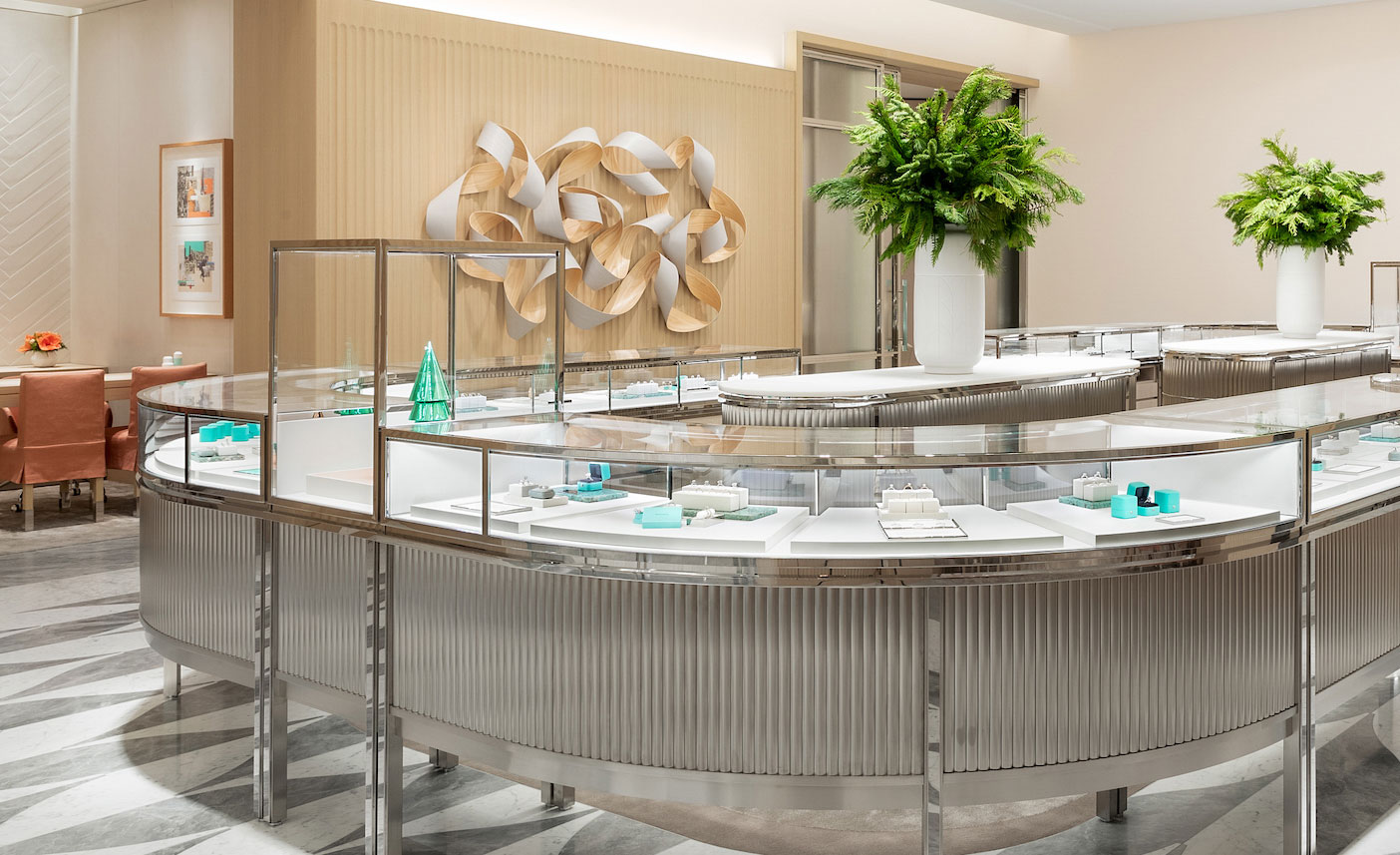
5.2 Building a Custom Jewelry Showcase: 3 Essentials
Designing a custom jewelry showcase requires focusing on three key elements:
🎨 1. Colors & Materials
Luxury brands often use:
- Metals: Gold-plated brass for timeless elegance.
- Glass: Anti-reflective types for glare-free viewing.
- Wood/Leather: Walnut or suede for rich texture.
🏷️ 2. Logo Integration
Brands enhance recall through:
- Engraved frames for subtle sophistication.
- LED-backlit logos that create a glowing effect.
- Monogrammed velvet linings for added luxury.
🔳 3. Shape & Structure
Match the boutique’s vibe with:
- Minimalist glass cases for a modern look.
- Ornate carvings for a heritage feel.
- Smart screens for a tech-forward approach.
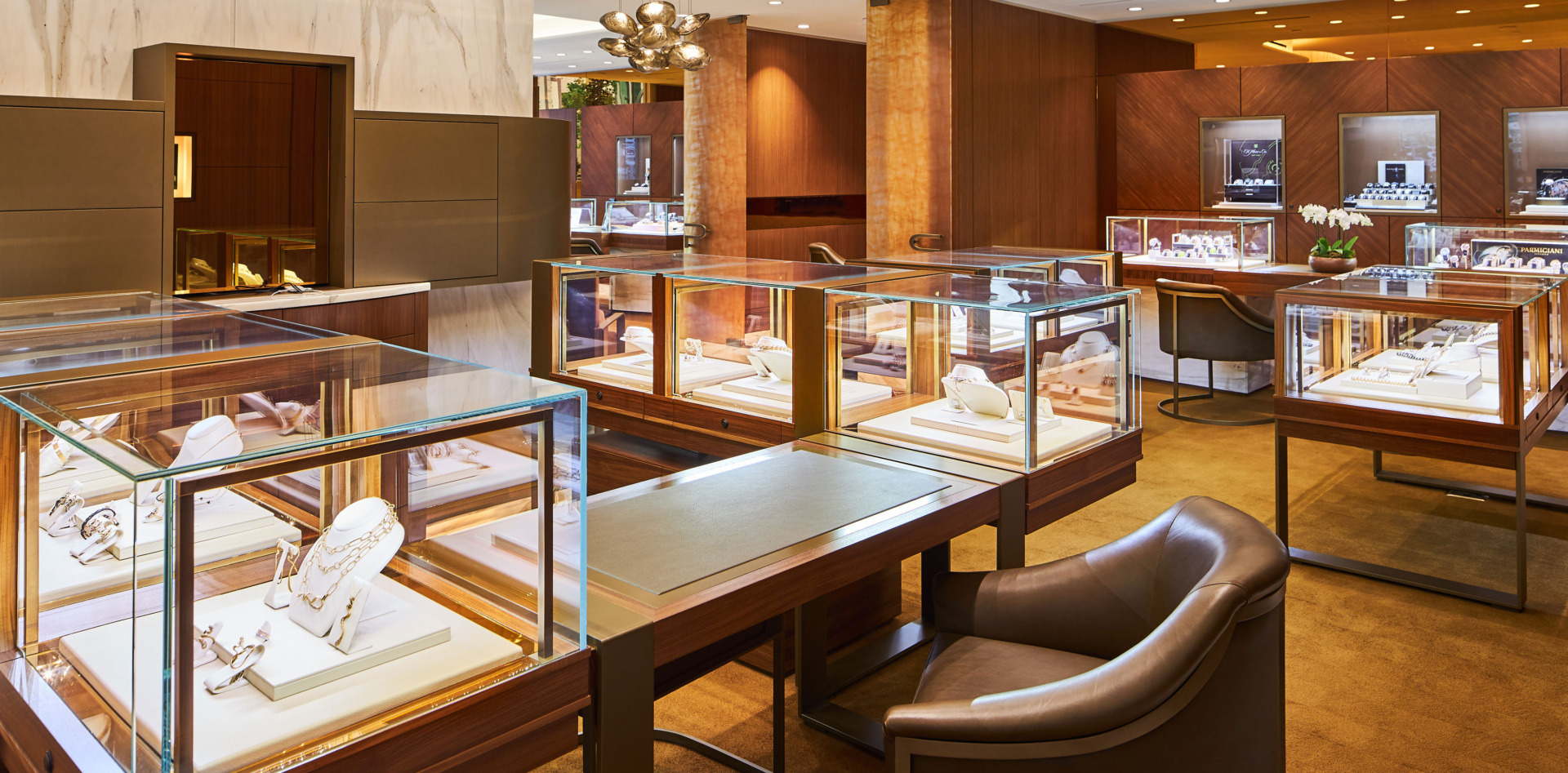
5.3 Case Studies: Brands Nailing Custom Displays
👜 Hermès: Subtle Luxury
- Warm wood tones combined with soft lighting create an inviting luxury atmosphere.
- Showcases seamlessly blend with boutiques for a cohesive experience.
👑 Cartier: Signature Gold
- Gold accents strongly reflect the brand’s identity.
- High-gloss finishes add a royal touch.
💎 Tiffany & Co.: Iconic Blue
- Tiffany Blue dominates every display, reinforcing brand identity.
- White LEDs enhance the elegance of diamonds.
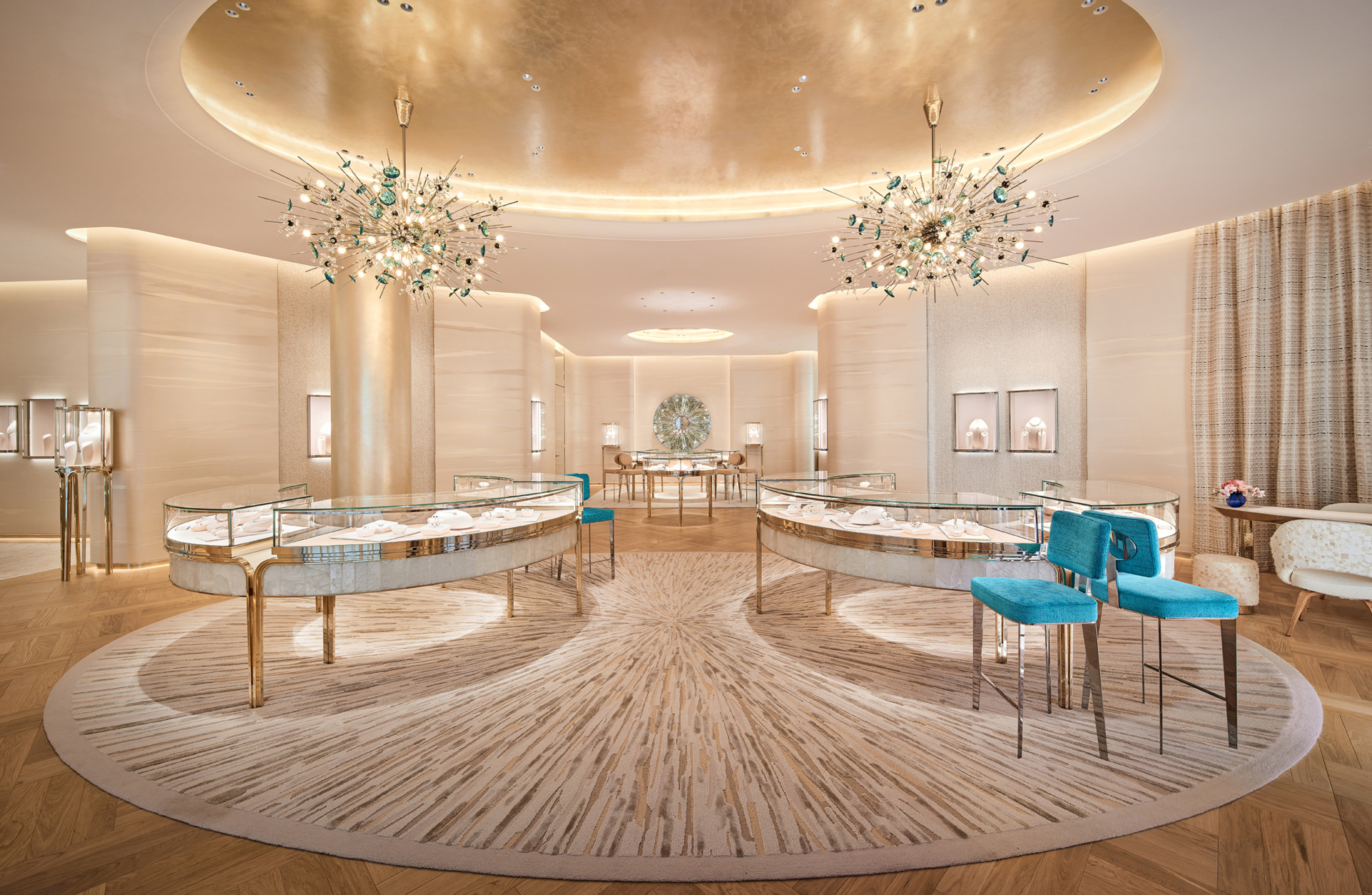
5.4 Driving Engagement Through Design
Luxury jewelry thrives on emotion. A well-designed jewelry showcase enhances this by:
- Open displays that encourage hands-on exploration.
- Lighting that highlights the beauty of gems.
- Ergonomic angles that make browsing comfortable.
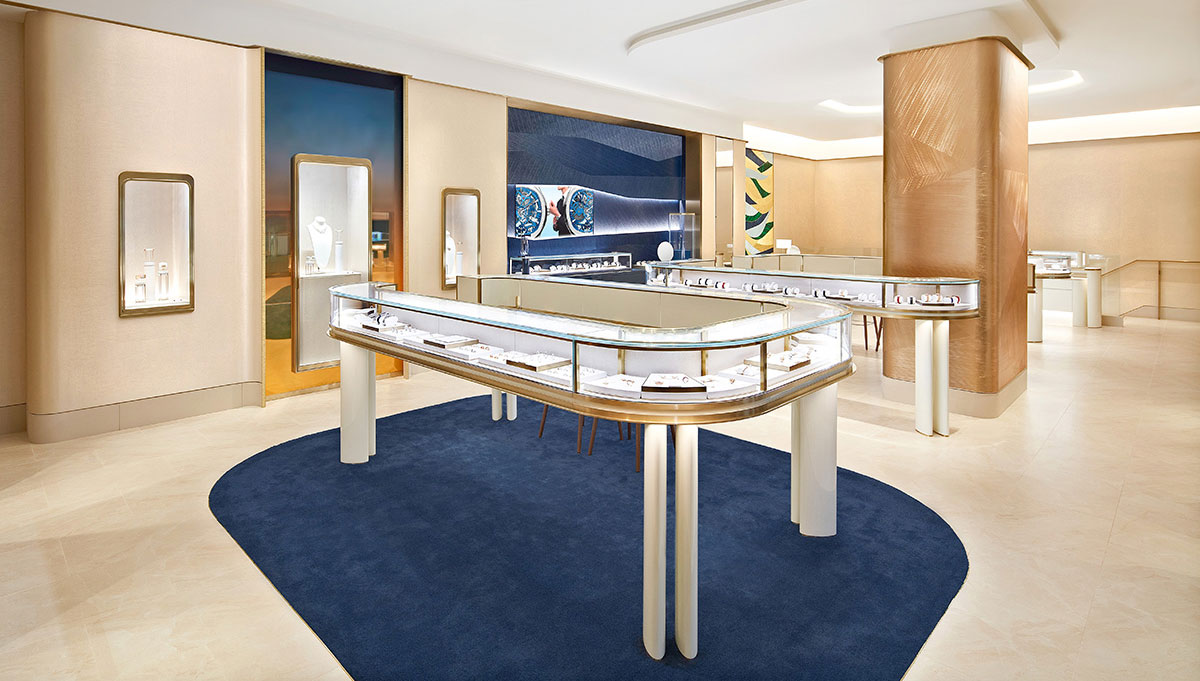
5.5 The Future: Smart, Sustainable Showcases
Technology is revolutionizing jewelry showcases. Future displays will feature:
- AI sensors that recommend pieces based on preferences.
- AR mirrors for virtual diamond try-ons.
- Eco-materials like recycled glass and bamboo for sustainability.
Section 6: The Pros and Cons of Different Jewelry Showcase Designs
Choosing the right jewelry showcase design is crucial for luxury brands. Not only does it impact product presentation, but it also shapes customer experience and store aesthetics. While each design offers unique advantages, it’s important to weigh their limitations carefully.
In this section, we’ll analyze various showcase designs to help distributors and agents make informed decisions. By comparing options like counter displays and smart showcases, we’ll build on the previous discussion about customization and prepare for real-world case studies.
6.1 Counter Showcase
💎 Definition: Waist-high display cases where staff present jewelry to customers.
✅ Pros:
✔ Security Focus: Lockable glass protects high-value items.
✔ Direct Interaction: Staff can demonstrate jewelry up close.
✔ Space Efficiency: Built-in storage maximizes limited areas.
✔ Adaptability: Works in both boutiques and large stores.
❌ Cons:
✖ Limited Visibility: Customers must stand close to view items.
✖ Dependence on Staff: Browsing requires constant assistance.
6.2 Wall-Mounted Showcase
💎 Definition: Fixed displays attached to walls, elevating jewelry to eye level.
✅ Pros:
✔ Space-Saving: Perfect for compact boutiques.
✔ Visual Appeal: Mimics museum-style elegance.
✔ Clear Visibility: Items are displayed at natural viewing height.
❌ Cons:
✖ Restricted Access: Customers need staff help to interact.
✖ Rigid Layout: Difficult to reposition once installed.
6.3 Freestanding Showcases
💎 Definition: Standalone cases offering 360-degree visibility.
✅ Pros:
✔ Layout Flexibility: Easily repositioned to match store themes.
✔ Immersive Viewing: Customers can examine items from all angles.
✔ Premium Impact: Highlights exclusive collections effectively.
❌ Cons:
✖ Space Demands: Unsuitable for small stores.
✖ Security Needs: Requires advanced locks due to exposure.
6.4 Window Display Cases
💎 Definition: Front-facing showcases are designed to attract foot traffic.
✅ Pros:
✔ Brand Exposure: Captivates passersby with eye-catching designs.
✔ Foot Traffic Boost: Draws customers in with seasonal themes.
✔ Storytelling Potential: Supports campaigns like holiday collections.
❌ Cons:
✖ Light Sensitivity: Sunlight glare can obscure visibility.
✖ Security Risks: Requires reinforced glass and alarms.
✖ Maintenance Demands: Displays need frequent updates.
6.5 Portable & Pop-up Showcases
💎 Definition: Modular displays for temporary events or pop-up stores.
✅ Pros:
✔ Portability: Easy to transport and assemble.
✔ Affordability: Lower cost than permanent fixtures.
✔ Event-Ready: Ideal for trade shows or brand activations.
❌ Cons:
✖ Durability Issues: Less robust than fixed designs.
✖ Design Limitations: Fewer customization options.
6.6 Smart Showcases
💎 Definition: Tech-driven displays with AR, touchscreens, and AI.
✅ Pros:
✔ Interactive Features: Lets customers explore products digitally.
✔ Advanced Security: Uses biometrics for theft prevention.
✔ Personalization: AI tailors recommendations to preferences.
❌ Cons:
✖ High Costs: Significant upfront investment is required.
✖ Technical Demands: Requires ongoing IT support.
6.7 How to Choose the Right Jewelry Showcase Design
To select the best design, consider these five factors:
6.7.1 Brand Alignment
Does the showcase reflect your brand’s luxury image and customer expectations?
6.7.2 Space Optimization
Will the design enhance store flow without overcrowding?
6.7.3 Product Suitability
Is the showcase tailored to your jewelry type (e.g., rings vs. necklaces)?
6.7.4 Security Needs
Does it include anti-theft features like alarms or reinforced glass?
6.7.5 Budget & ROI
Does the investment align with long-term returns?
Section 7: Examples and Case Studies
Understanding jewelry showcase designs is essential, but seeing them in action clarifies their true impact. In this section, we analyze how leading luxury brands leverage showcase designs to elevate brand perception, improve customer experiences, and boost sales.
Why Case Studies Matter
These real-world examples demonstrate the value of custom showcases. Additionally, they offer actionable insights for distributors and agents aiming to refine their retail strategies.
7.1 Cartier – Timeless Elegance in Retail Design
Showcase Strategy
Cartier combines freestanding and counter showcases to craft a luxurious shopping environment. This approach balances visual appeal with personalized service.
Key Highlights
- 360-Degree Visibility: Freestanding cases highlight high-value items like diamond necklaces.
- Personalized Interaction: Counter displays let staff present jewelry in a refined, one-on-one setting.
- Strategic Lighting: Warm LEDs enhance the brilliance of gold and gemstones, amplifying the store’s opulence.
Results
📌 Cartier’s strategy reinforces its brand identity, attracting affluent clients while ensuring security.
7.2 Tiffany & Co. – Modernizing Tradition
Showcase Strategy
Tiffany & Co. merges classic elegance with technology. For example, window displays and smart showcases engage customers both inside and outside stores.
Key Highlights
- Seasonal Displays: Flagship locations like New York’s 5th Avenue use themed windows to draw crowds.
- Interactive Tech: Touchscreens let customers explore engagement ring details.
- Minimalist Design: Wall-mounted cases keep layouts clean, emphasizing delicate pieces.
Results
📌 This blend of tradition and innovation maintains Tiffany’s luxury appeal while attracting tech-savvy shoppers.
7.3 Van Cleef & Arpels – Art Gallery Aesthetics
Showcase Strategy
Van Cleef & Arpels uses wall-mounted and freestanding displays to showcase jewelry as wearable art.
Key Highlights
- Artistic Presentation: Wall displays position high-jewelry pieces like museum exhibits.
- Subtle Lighting: Soft illumination highlights intricate details without glare.
- Discreet Security: Hidden locks protect items without disrupting visual harmony.
Results
📌 The gallery-like ambiance makes customers feel part of an exclusive, curated experience.
7.4 Bulgari – Heritage Meets Innovation
Showcase Strategy
Bulgari blends bold designs with tech-driven features. For instance, Roman-inspired counters coexist with AR-enabled displays.
Key Highlights
- Heritage Design: Gold-accented counters reflect the brand’s Roman roots.
- Pop-Up Flexibility: Temporary displays engage VIP clients at global events.
- AR Integration: Virtual try-ons simplify decision-making for customers.
Results
📌 This strategy cements Bulgari’s reputation as a pioneer in experiential luxury retail.
7.5 How to Apply These Lessons to Your Business
To adapt these strategies, focus on four core principles:
7.5.1 Align with Brand Identity
Ensure your showcases reflect your brand’s luxury image. For example, minimalist designs suit modern brands, while ornate styles fit heritage labels.
7.5.2 Prioritize Customer Engagement
Use interactive elements like touchscreens or AR to create memorable shopping experiences.
7.5.3 Balance Security and Aesthetics
Opt for discreet locks and reinforced glass to protect items without sacrificing design.
7.5.4 Embrace Technology
Smart showcases attract younger audiences and streamline the purchasing process.
Section 8: How to Choose the Right Jewelry Showcase for Your Business
Selecting the ideal jewelry showcase is critical for luxury distributors and agents. A strategic choice not only highlights products effectively but also reinforces brand identity, improves customer engagement, and ensures secure displays.
In this section, we’ll guide you through decision-making using insights from earlier case studies. Key considerations include brand alignment, store design, budget planning, and supplier partnerships.
8.1 Align with Brand Positioning
Every luxury brand has a distinct identity. To maintain consistency, your showcase design must mirror this identity.
Heritage & Classic Brands (e.g., Cartier, Van Cleef & Arpels)
- Recommended Designs: Freestanding or wall-mounted displays, counter showcases.
- Key Features: Brass frames, velvet linings, and warm lighting for timeless elegance.
Modern & Innovative Brands (e.g., Bulgari, Tiffany & Co.)
- Recommended Designs: Smart showcases with AR technology or interactive window displays.
- Key Features: Minimalist aesthetics, touchscreens, and dynamic lighting.
High-Fashion Brands
- Recommended Designs: Modular pop-up cases or bold window displays.
- Key Features: Vibrant colors and adaptable layouts for seasonal updates.
💡 Tip: Always match materials and lighting to your brand’s visual guidelines.
8.2 Adapt to Store Layout
Your store’s design dictates showcase placement. Below are tailored recommendations for different retail spaces:
For Boutiques & Showrooms
- Best Options: Freestanding or wall-mounted showcases.
- Why They Work: These create an exclusive, VIP-friendly atmosphere.
For Department Stores
- Best Options: Counter displays or smart showcases.
- Why They Work: They maximize space while keeping branding prominent.
For Pop-Up Stores
- Best Options: Portable or modular showcases.
- Why They Work: Easy to transport and assemble for temporary events.
💡 Tip: Combine showcase types to balance aesthetics and customer flow.
8.3 Balance Budget and Quality
Luxury showcases are long-term investments. Here’s how to align costs with goals:
Premium Tier (10K–50K)
- Best For: Flagship stores requiring custom designs and advanced tech.
- Benefits: High-end materials, tailored branding, and future-proof features.
Mid-Tier (3K–10K)
- Best For: Franchise retailers needing durability and customization.
- Benefits: Refined designs with moderate personalization.
Entry-Level (1K–3K)
- Best For: Pop-ups or retailers prioritizing affordability.
- Benefits: Functional displays with basic security.
💡 Tip: Prioritize ROI—quality showcases attract high-spending clients.
8.4 Evaluate Jewelry Showcase Manufacturers
Choosing the right supplier ensures a seamless blend of design and functionality.
8.4.1 Expertise
Do they specialize in luxury retail displays?
8.4.2 Customization
Can they adapt designs to your brand’s needs?
8.4.3 Materials
Do they use anti-reflective glass or solid wood?
8.4.4 Security
Are smart locks and reinforced glass included?
8.4.5 Logistics
Can they handle global delivery and installation?
💡 Tip: Always request samples and 3D mockups before committing.
8.5 Final Checklist for Decision-Making
Before purchasing, ask:
✅ Brand Alignment: Does the design reflect your luxury image?
✅ Space Efficiency: Will it fit your store layout?
✅ Budget Fit: Is the cost justified by quality and ROI?
✅ Security: Does it protect items discreetly?
✅ Supplier Reputation: Is the manufacturer experienced in luxury projects?
By addressing these points, you’ll select showcases that boost brand value, customer satisfaction, and sales.
Section 9: Jewelry Showcase Maintenance and Best Practices
Luxury jewelry showcases are long-term investments that shape brand perception, customer trust, and product safety. To ensure they remain elegant and functional, regular care and strategic planning are critical.
In this section, we’ll share actionable maintenance tips and key reminders to help distributors and agents protect their investments.
9.1 Routine Maintenance for Showcase Quality
Why It Matters: Proper upkeep preserves both aesthetics and security. Follow these steps:
9.1.1 Cleaning & Polishing
- Glass Surfaces: Use microfiber cloths and anti-static cleaners. Avoid ammonia-based products to protect coatings.
- Metal Frames: Polish brass, stainless steel, or aluminum with non-abrasive solutions.
- Wood/Leather: Wipe gently with mild cleaners and avoid excess moisture.
9.1.2 Lighting Maintenance
- Replace dim LED bulbs immediately.
- Dust light fixtures monthly for optimal brightness.
- Adjust angles to highlight gemstone brilliance.
9.1.3 Security Checks
- Test smart locks and alarms quarterly.
- Inspect reinforced glass for cracks or weaknesses.
💡 Tip: Schedule professional inspections twice yearly for mechanical and electrical systems.
9.2 Extending Showcase Lifespan
While high-quality showcases last years, their durability depends on three factors:
9.2.1 Material Choices
Opt for tempered glass, solid wood, and corrosion-resistant metals.
9.2.2 Environmental Control
Maintain stable humidity (40–60%) and temperature (18–24°C) to prevent damage.
9.2.3 Staff Training
Train teams to handle showcases gently to minimize wear.
💡 Tip: Rotate displayed jewelry every 3 months to prevent uneven wear.
9.3 Avoiding Costly Mistakes
Mistake #1: Style Over Function
- Problem: Prioritizing looks over security or usability.
- Fix: Balance design with features like smart locks and ergonomic layouts.
Mistake #2: Poor Lighting
- Problem: Low-quality lights make gems look dull.
- Fix: Use LEDs with a CRI >90 for accurate color rendering.
Mistake #3: Weak Security
- Problem: Increased theft risk due to outdated systems.
- Fix: Install reinforced glass and biometric locks.
Mistake #4: Inflexible Designs
- Problem: Fixed showcases hinder store updates.
- Fix: Choose modular units that adapt to layout changes.
💡 Tip: Partner with manufacturers early to avoid design flaws.
9.4 Smart Investment Strategies
Key Principles for Success
- Brand Alignment: Ensure that the showcases match your luxury image (e.g., gold accents for heritage brands).
- Material Quality: Invest in durable materials to reduce long-term costs.
- Layout Updates: Refresh displays seasonally to captivate customers.
- Customer Experience: The Position showcases at 45-degree angles for easy viewing.
💡 Tip: A well-planned showcase boosts sales, protects inventory, and elevates shopping experiences.
Section 10: Emerging Trends in Luxury Jewelry Showcases
The luxury jewelry industry is evolving rapidly, driven by technology, sustainability, and personalized experiences. In this section, we explore cutting-edge trends that are redefining how high-end jewelry is displayed—and how these innovations can help distributors and agents stay competitive.
10.1 Smart Technology in Jewelry Showcases
Interactive Displays for Enhanced Engagement
- Touchscreen Features: Allow customers to browse collections and customize designs digitally.
- AR Virtual Try-Ons: Shoppers can visualize jewelry on themselves without physical contact.
- Example: Tiffany & Co. uses AR in flagship stores to boost customer interaction.
AI-Driven Personalization
- Tailored Recommendations: AI analyzes browsing history to suggest relevant pieces.
- VIP Recognition: Facial recognition identifies loyal clients and displays personalized items.
- Example: Cartier’s AI showcases adapt displays based on customer preferences.
Automated Functionality
- Smart Glass: Switches from clear to opaque for privacy with a tap.
- Motorized Displays: Rotating platforms highlight jewelry from all angles.
- Example: App-controlled lighting systems are trending in luxury boutiques.
💡 Key Takeaway: Smart tech improves engagement, security, and brand prestige.
10.2 Sustainable Showcase Design
Eco-Friendly Materials
- Recycled Glass/Metal: Maintains luxury appeal while reducing environmental impact.
- Bamboo & Vegan Leather: Alternatives to traditional wood and leather finishes.
- Example: Leading brands use FSC-certified wood to meet sustainability goals.
Energy Efficiency
- Motion-Sensor LEDs: Save energy without compromising brightness.
- Solar-Powered Cases: Emerging as a solution for carbon-neutral stores.
- Example: A major brand’s Paris boutique runs entirely on solar energy.
💡 Key Takeaway: Sustainability aligns with consumer values and regulatory demands.
10.3 Hyper-Personalized Showcases
Adaptive Designs
- Modular Units: Easily reconfigured for seasonal collections or events.
- Multi-Functional Cases: Convert from wall displays to portable pop-ups.
- Example: Van Cleef & Arpels uses modular cases for global exhibitions.
Multi-Sensory Branding
- Custom Scents & Lighting: Create immersive environments tied to brand identity.
- Engraved Details: Logos or patterns etched into glass or metal frames.
- Example: A luxury brand’s signature scent increases dwell time by 20%.
💡 Key Takeaway: Personalization drives exclusivity and customer loyalty.
10.4 Advanced Security Solutions
Biometric Systems
- Fingerprint Locks: Replace keys for secure, quick access.
- AI Surveillance: Cameras detect suspicious activity and trigger alarms.
- Example: Flagship stores in Tokyo use AI to prevent theft.
Digital Verification
- Blockchain Tracking: Links showcases to digital certificates for authenticity.
- NFT Integration: Buyers verify ownership via blockchain records.
- Example: A diamond brand uses NFTs to combat counterfeiting.
💡 Key Takeaway: Next-gen security protects assets and builds trust.
10.5 Omnichannel Retail Integration
Seamless Online/Offline Links
- QR Code Scanners: Customers check online stock or buy via smartphones.
- Live Demo Cameras: Staff showcase pieces remotely through built-in screens.
- Example: Bulgari’s connected displays increased online sales by 35%.
💡 Key Takeaway: Omnichannel strategies enhance convenience and sales.
Section 11: Essential Resources for Luxury Jewelry Showcases
Choosing the perfect jewelry showcase is a major investment for luxury brands. To make informed decisions, distributors and agents need access to expert insights, supplier networks, and industry trends. This section curates the best resources—from trade shows to trusted manufacturers—to help you stay ahead.
11.1 Top Industry Blogs and Publications
Why They’re Important: Blogs and magazines offer actionable insights into design trends and technology. Here are the most trusted sources:
11.1.1 Design & Innovation
- Retail Design Blog: Analyzes luxury store layouts and showcases trends.
- Dezeen/Architectural Digest: Features award-winning boutique interiors.
11.1.2 Market Trends
- The Jewelry Magazine: Covers display innovations for high-end jewelry.
- Luxury Society: Explores branding strategies for luxury retail.
💡 Key Takeaway: Regularly follow these platforms to inspire creative showcase designs and retail strategies.
11.2 Must-Attend Trade Shows
Why Attend? Trade shows let you network with suppliers and discover cutting-edge designs.
11.2.1 Global Events
- Baselworld (Switzerland): Premier event for luxury retail innovations.
- JCK Las Vegas (USA): Showcases top manufacturers and tech solutions.
- Vicenzaoro (Italy): Connects brands with European display experts.
11.2.2 Regional Highlights
- Hong Kong International Jewellery Show: Asia’s hub for premium showcases.
- Luxury Packaging London: Focuses on sustainable display trends.
💡 Tip: Prioritize events aligned with your brand’s geographic and design goals.
11.3 Choosing a Reliable Manufacturer
Selecting the right supplier ensures quality and brand alignment. Focus on these criteria:
11.3.1 Expertise & Customization
- Luxury Experience: Do they work with brands like Cartier or Bulgari?
- Tailored Solutions: Can they integrate custom branding and security?
11.3.2 Material & Technology
- Premium Materials: Anti-reflective glass, solid wood, or vegan leather.
- Smart Features: Motion-sensor lighting or AI security systems.
11.3.3 Global Support
- Logistics: Worldwide shipping and on-site installation services.
Where to Find Suppliers?
- Trade Shows: Meet suppliers directly at events like JCK Las Vegas.
- Online Directories: Search Alibaba or ThomasNet for specialized manufacturers.
💡 Key Takeaway: A reputable supplier elevates brand value and customer trust.
11.4 Market Research & Reports
Why Research Matters: Data-driven insights guide showcase investments.
11.4.1 Consumer Trends
- McKinsey’s Future of Luxury Retail: Explores in-store tech adoption.
- Euromonitor’s Luxury Goods Report: Analyzes customer preferences.
11.4.2 Design Innovations
- WGSN Retail Trends: Predicts upcoming showcase aesthetics.
- JewelleryNet Reports: Details advancements in security and lighting.
💡 Tip: Use reports to justify budgets and align with industry standards.
11.5 Staying Updated on Trends
Why It’s Critical: The luxury market evolves rapidly. Monitor these sources:
11.5.1 News Platforms
- Luxury Daily: Covers AR/VR integration in displays.
- Business of Fashion: Highlights omnichannel retail strategies.
11.5.2 Niche Blogs
- Jewellery World News: Focuses on anti-theft tech and lighting.
- High-End Retail Blogs: Share case studies from top designers.
💡 Key Takeaway: Adapting to trends ensures your showcases remain innovative and secure.
Conclusion: The Importance of High-End Custom Jewelry Showcase
In luxury jewelry retail, every detail plays a crucial role. From the intricate craftsmanship of each piece to the ambiance of a boutique, presentation shapes customer perception. A well-designed jewelry showcase does more than display products—it enhances brand identity, elevates the shopping experience, and serves as a strategic investment in retail success.
Key Insights from This Guide
This guide has explored essential aspects of luxury jewelry showcases, including:
🔹 The Role of Jewelry Showcase – More than a display, a showcase increases product appeal and reinforces brand value.
🔹 Types of Jewelry Showcase – From counter displays to smart showcases, each serves a distinct purpose.
🔹 Customization & Branding – Tailored designs help luxury brands stand out in a competitive market.
🔹 Design Considerations – Factors like materials, lighting, security, and functionality shape the ideal showcase.
🔹 Pros & Cons of Different Designs – Understanding various options helps businesses choose the best solution.
🔹 Case Studies – Real-world examples demonstrate how top brands leverage showcases for success.
🔹 How to Choose the Right Showcase – A step-by-step guide for distributors and agents to make informed decisions.
🔹 Maintenance & Best Practices – Ensuring longevity and pristine condition of high-end showcases.
🔹 Future Trends – Smart technology, sustainability, and personalization are shaping the next generation of showcases.
🔹 Industry Resources – Key reports, trade shows, and suppliers to help businesses stay competitive.
Why the Right Showcase Matters for Luxury Jewelry Distributors & Agents
For distributors and agents, selecting the right jewelry showcase goes beyond aesthetics—it is a strategic decision that impacts business growth. A well-crafted showcase:
✅ Enhances customer engagement, making the shopping experience more immersive.
✅ Strengthens brand identity through premium design and tailored features.
✅ Provides security and durability, protecting valuable jewelry investments.
✅ Optimizes retail space with efficient layouts and interactive elements.
✅ Adapts to future trends with smart technology and sustainable materials.
Investing in high-end custom showcases ensures that luxury jewelry collections are displayed in a way that captivates buyers, reinforces brand prestige, and ultimately boosts sales. By making informed choices, businesses can create an unforgettable retail experience that aligns with their brand’s vision and market positioning.
Elevate Your Brand with Custom Jewelry Showcase
At RonRun Showcase Master, we specialize in designing and crafting high-end, bespoke jewelry showcases that blend luxury, functionality, and innovation. Our expertise in working with leading international brands allows us to deliver solutions tailored to the unique needs of premium jewelry retailers, distributors, and agents.
Looking for the perfect jewelry showcase to represent your brand?
📩 Contact us today to discuss your custom requirements and receive a personalized consultation.
🌍 Visit our website to explore our past projects and see how our luxury showcases can transform your retail space.
Let’s create a display showcase that tells your brand’s story and captivates your customers.



